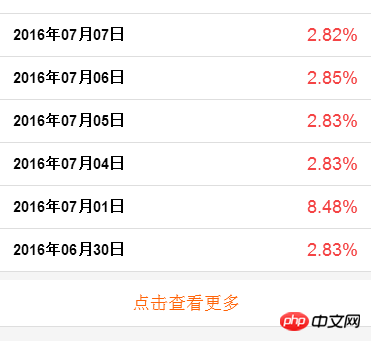
This article mainly introduces the relevant information about Ajax clicking to continuously load the data list. Friends who need it can refer to it
Introduction to Ajax
AJAX stands for "Asynchronous Javascript And XML" (asynchronous JavaScript and XML), which refers to a web development technology for creating interactive web applications.
AJAX = Asynchronous JavaScript and XML (a subset of Standard Universal Markup Language).
AJAX is a technology for creating fast, dynamic web pages.
By exchanging a small amount of data with the server in the background, AJAX can enable asynchronous updates of web pages. This means that parts of a web page can be updated without reloading the entire page.
Traditional web pages (not using AJAX) must reload the entire web page if the content needs to be updated.
There are various methods and ideas to implement each function. Today I will summarize a small loading function of mine.
Loading is very common, and every mobile phone user is very familiar with her. Every time we scroll through Weibo, Moments, Space... and slide to a certain amount, we will be reminded to slide up to load more. This is one way of loading; the other is to click to load, click to load A certain amount, then click, and then load a certain amount (a lot of nonsense).
Now let’s talk about ajax loading data one by one, similar to this data list.

First display 10, then click to load more, then display 10 more...

##1. Idea
var ci = 0;
for(var i = 0; i < data.list.length; i++){
ci++;
if(ci> 10){
break;
}
} 2. Implement the function
HTML:
<dl id="incomeNum"> <dt><em></em>每日分配收益</dt> </dl> <p class="jiaZai_more">点击查看更多</p>
css:
js:
function nwalletProfit(num, cNum){
$.ajax({
type: "post",
async: true,
url: url,
dataType: "json",
success: function (data) {
if (data.list.length > 0){
var i = num;
var ci= 0;
var x = parseInt((data.profit_list.length)/10);//x为每10个一组的组数
if(cNum >= x){
$(".jiaZai_more").hide(); //当点击更多的次数 ≥ 组数时,隐藏按钮
}
for(; i < data.profit_list.length; i++){
var htmltxt = "";
ci++;
var date = data.profit_list[i].date;
var year = date.substring(0, 4);
var month = date.substring(4, 6);
var day = date.substring(6);
date = year+'年'+month+'月'+day+'日';
htmltxt += '<dd>';
htmltxt += '<h5 class="date">'+date+'</h5>';
htmltxt += '<p class="income">'+data.list[i].profit+'%</p>';
if(ci> 10){
break;
}
$("#incomeNum").append(htmltxt);
}
}
},
error: function (e, d, c) {
console.log(d)
}
});
}
nwalletProfit(0);
var clickNum = 0; //点击的次数
$(".jiaZai_more").on('click', function(event) {
event.preventDefault();
clickNum++;
var iNum = 10*clickNum; //每次点击开始加载的第一个索引值
nwalletProfit(iNum, clickNum);
});Simple implementation of Ajax uploading pictures and previewing
Summary of techniques for file upload based on ajax html
Simple application based on Ajax form submission and background processing
# #
The above is the detailed content of Ajax click to continuously load the data list (graphic tutorial). For more information, please follow other related articles on the PHP Chinese website!




